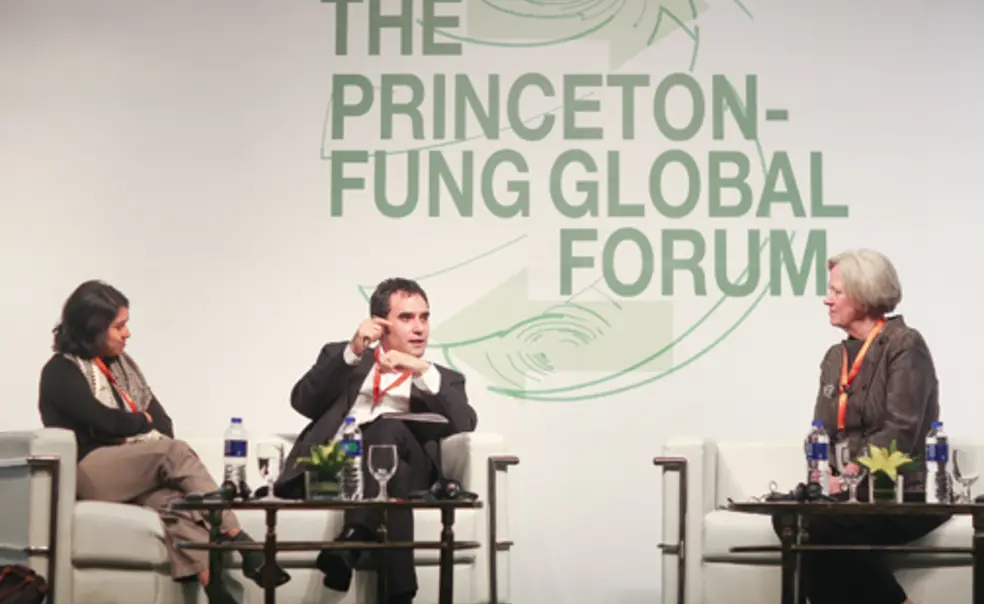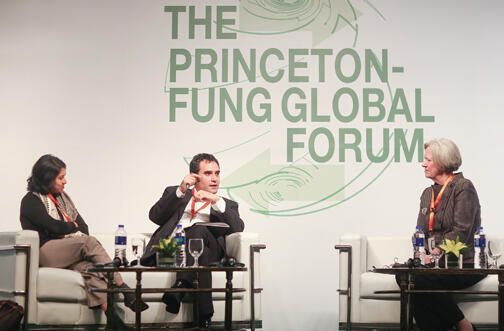President's Page
During Intersession, I joined Provost Christopher Eisgruber ’83 and 19 faculty colleagues on a 7,400- mile journey to Shanghai, China’s largest city and a breathtaking illustration of the economic forces transforming this vast and populous country. Our destination was the Princeton-Fung Global Forum, the first in a series of conferences, to be held in a different location each year, designed to bring together the world’s best minds around a topic of importance to the international community. Organized by the Council for International Teaching and Research, under the able direction of Professor of History Jeremy Adelman, and generously funded by Princeton trustee William Fung ’70, the forum is a unique opportunity to present our faculty’s research to a worldwide audience, to forge connections with scholars, practitioners, and policymakers without respect to discipline or region, and to advance the goal that the provost and I laid out five years ago—to be an American university with a truly global vision expressed through active engagement with the world.
The theme of this inaugural forum was “The Future of the City,” reflecting the fact that a majority of people now live in urban settings and that some of these environments are engaged in some of the most ambitious transformations in social organization, cultural expression, and technological innovation that the world has witnessed. In fact, it could be argued that the city is itself a grand experiment, reaching across millennia and posing new challenges for every problem it successfully resolves. As if to underscore this point, Shanghai was blanketed in heavy smog when we arrived, China Daily reporting that “residents living in the Yangtze River Delta breathed the most polluted air in five years during the past two weeks,” with vehicles, coal stoves, and factory emissions deemed the major culprits.
In the course of the three-day forum, speakers from multiple countries and fields brought their distinct perspectives to bear on both the strengths and vulnerabilities of 21st-century cities, from concepts of belonging and equity, to the optimization of urban infrastructure, to the perils of climate change for coastal population centers. With Hurricane Sandy still fresh in our minds, the forum’s exploration of this last issue was a welcome opportunity to view such catastrophic events through a global lens, not only with respect to impacts but, importantly, in terms of finding new solutions. One of the most engaging— and hopeful—aspects of the forum was a multinational exhibit entitled “The Resilient City,” which documented efforts to strengthen urban areas, be it by constructing earthquake- and fire-resistant buildings; by developing “soft infrastructure” such as earthen berms, wetlands, and barrier islands in response to rising sea levels; or by engaging in “structural health monitoring” (SHM). Forum participant and Assistant Professor of Civil and Environmental Engineering Branko Glisic likens SHM of buildings to the human nervous system insofar as its goal is to detect structural defects, assess their severity, and then trigger an appropriate response. Indeed, the forum underscored the fact that cities, for all their concentrated brick and mortar, are living organisms, with their own ethos and complex dynamics.
Having looked at the city from many angles, including its depiction in film with filmmaker Andrew Jarecki ’85, the forum concluded with a session moderated by Provost Eisgruber that synthesized the challenges faced by contemporary urban areas. My hope is that our faculty and their international counterparts, as well as the alumni, local students, and others in attendance, have been inspired to embrace these challenges with even greater passion and, through their work, engage an audience that stretches far beyond Shanghai or Princeton.
In closing, I would like to touch on a new initiative that is closely related to the one I have described, namely, the Fung Global Fellows Program. Just as our faculty and students must leave the “orange bubble” to interact with colleagues and peers around the world, it is important that we encourage international scholars to come to Princeton. The same gift that made possible our conference in Shanghai and those to come has allowed us to annually invite six outstanding early-career faculty in the humanities and social sciences to spend a year on campus focusing on a broad topic of common interest. The first cohort will take up residence this fall, working with each other and with our faculty and students to shed new light on the nexus of “languages and authority” in potential contexts ranging from language policy to nation-state formation to social stratification. Although their time with us will be comparatively short, the ties these fellows form will endure much longer, creating a host of new collaborative opportunities.
In a world that seems to grow smaller by the day, I am delighted that our University is developing an array of international relationships, bringing us into direct and sustained contact with ideas and issues that will shape the future of our planet. Thanks to alumni like William Fung and the caliber of faculty who traveled with me to Shanghai, Princeton will be able to contribute richly to this conversation.
The Alumni Weekly provides these pages to the president.














No responses yet